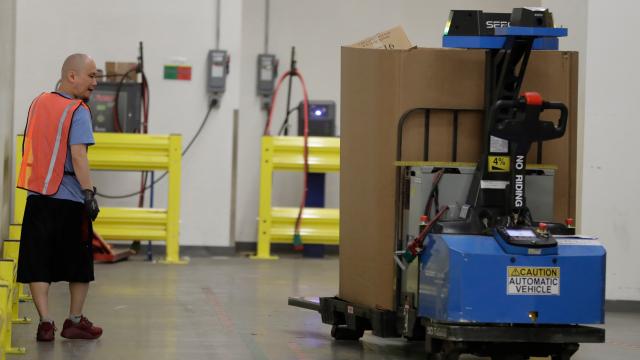Amazon has begun rolling out a “new worker safety wearable” to over 25 of its locations over the past year, TechCrunch reported on Friday—namely, a “Robotic Tech Vest” that alerts robots to the location of workers within a facility in order to prevent workplace accidents.
The vest in question has built-in sensors that allow Amazon robots to detect obstacles (in this case, humans) and manoeuvre around them. Amazon Robotics VP Brad Porter told TechCrunch that previously, workers would have to manually log their locations in an Amazon facility to avoid collisions with robots:
“All of our robotic systems employ multiple safety systems ranging from training materials, to physical barriers to entry, to process controls, to on-board,” Amazon Robotics VP Brad Porter told TechCrunch. “In the past, associates would mark out the grid of cells where they would be working in order to enable the robotic traffic planner to smartly route around that region. What the vest allows the robots to do is detect the human from farther away and smartly update its travel plan to steer clear without the need for the associate to explicitly mark out those zones.”
As TechCrunch noted, OSHA warns that studies suggest many robot accidents in U.S. workplaces “occur during non-routine operating conditions, such as programming, maintenance, testing, setup, or adjustment,” when workers may be “temporarily be within the robot’s working envelope.”
Amazon is moving full steam ahead with installing more and more robots in its distribution centres. Over the 2018 holiday season, the company hired less temporary staff yet broke its shipment records, a clear sign that automation is fuelling Amazon’s growth.
Porter added in his statement to TechCrunch that the vest has been a “huge success” and had logged over “one million unique activations.”
Amazon has reason to invest in safety. Its staff have repeatedly complained of long hours, constant on-the-job surveillance, and unfair pay—but also of preventable workplace injuries in its hectic warehouses.
Last April, the US National Council for Occupational Safety and Health released a report claiming that Amazon was one of the most dangerous workplaces in the country. The organisation wrote that CEO Jeff Bezos, the richest man in the world, gathered such riches “in large part, on a business model that features a relentless work pace and constant monitoring of employees.” Between 2013 and the release of the report, National COSH found that seven workers had died at Amazon warehouses.
Two were reportedly hit by large vehicles and two were killed by forklifts, but one was “killed after being dragged and crushed by a conveyor belt at an Amazon warehouse in Avenel, New Jersey” in 2013. Another was “rushed and pinned to death by a pallet loader at an Amazon warehouse in Carlisle, Pennsylvania” in 2014, according to the report.
Later in 2018, a Guardian investigation found “numerous cases” of workplace accidents or other injuries in Amazon’s labyrinthine supply chain, with many of the workers left “homeless, unable to work or bereft of income.”
More recently, dozens of workers were injured in December 2018 when, according to the Washington Post, an “automated machine” struck and broke open a 255.15g. can of bear repellent—containing among other things capsaicin, the chemical that gives spicy foods their zing and in high quantities is a powerful irritant.
[TechCrunch via Engadget]
